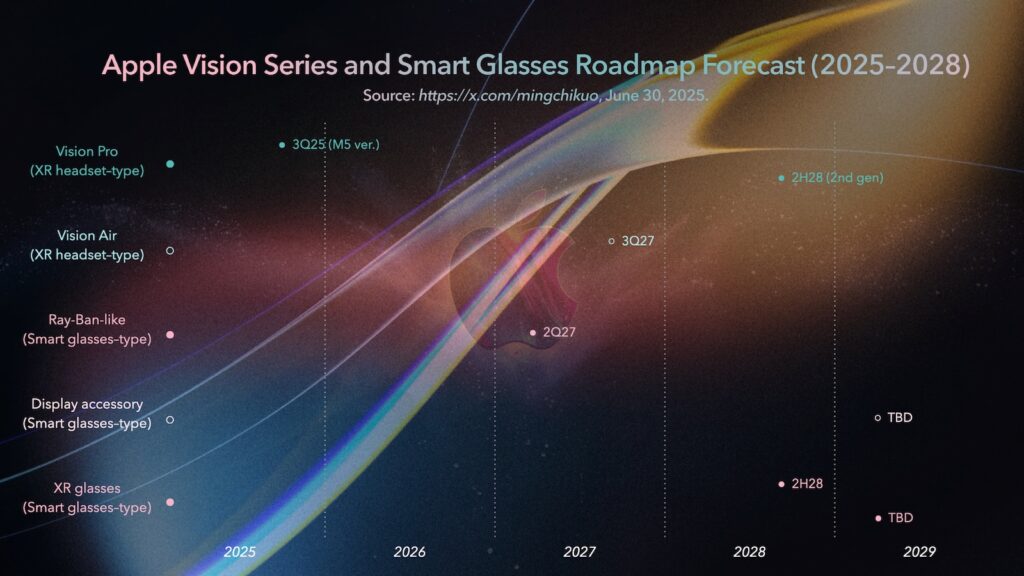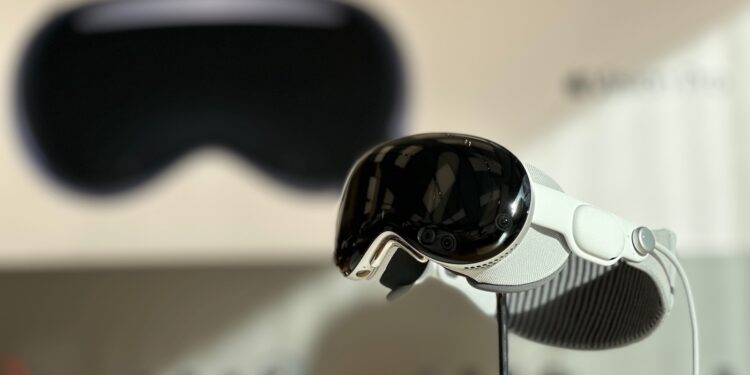Apple is deliberately pushing ahead with the development of head-mounted devices. According to analyst Ming-Chi Kuo, an entire product family is being developed behind the scenes around Apple Vision and smart glasses. Between 2025 and 2028, Apple plans to launch several new devices that are considered the next big wave in consumer electronics. This article provides a complete overview of Apple's strategy, roadmap, and key technical details.
One thing is already clear: Apple is serious about developing XR headsets and smart glasses. The iPhone will no longer be the only central device in the future. Smart glasses and mixed reality products are intended to establish a new device category. According to Kuo, Apple is currently working on at least seven devices, including three models from the Vision series and four pairs of smart glasses.
The Vision series: Apple's XR offensive
Vision Pro M5 (planned for 2025)
The next version of the Vision Pro is planned for the third quarter of 2025. It will be a moderate upgrade, primarily upgrading the processor from the M2 to the M5. The rest of the hardware remains largely unchanged. Apple plans to produce between 150,000 and 200,000 units. The product remains a niche model, with which Apple primarily intends to further develop the XR ecosystem, test applications, and efficiently utilize existing components.
Vision Air (planned for 2027)
In 2027, Apple will launch a completely new pair of XR glasses, the Vision Air. Its distinctive feature is its new form factor: over 40 percent lighter than the Vision Pro, thanks to plastic instead of glass, magnesium instead of titanium alloy, and a smaller number of sensors. The device will be positioned significantly lower than the Vision Pro. The processor will be the current flagship iPhone. Mass production is planned for the third quarter of 2027.
Vision Pro 2nd Generation (planned for 2028)
Apple plans to release a new generation of the Vision Pro with a completely new design in the second half of 2028. The device is expected to be lighter and more attractively priced. It will be equipped with a Mac processor, suggesting increased performance and deeper integration into the Apple ecosystem.

Smart glasses: entering the mass market
Ray-Ban-like smart glasses (planned for 2027)
The first truly mass-market smart glasses product will arrive in 2027. Apple plans to launch a pair of glasses without a display, but with audio capabilities, a camera, video recording, and AI-supported ambient sensing. Control will be via voice and gestures. The design is flexible, with various frame and temple materials. Mass production is scheduled for the second quarter of 2027. Apple expects 3 to 5 million units or more. Worldwide sales across all brands are expected to exceed 10 million devices, making this product category the first major smart glasses market ever. The glasses are designed to partially replace TWS headphones (e.g., AirPods) and smartphone cameras. For Apple, this represents an opportunity to define new everyday applications.
XR glasses with display (planned for 2028)
A pair of glasses with a built-in display will follow in 2028, using LCoS technology and waveguides to produce a color image. These, too, are operated via voice and gestures. AI functions play a central role – without a compelling AI experience, the device has no chance on the market, according to Kuo. Apple is simultaneously working on an additional version of these glasses, although the timeline is unclear and the priority is lower.
Display accessories (project currently paused)
Another product was originally planned for the second quarter of 2026: a wired display accessory for iPhones. This small device with a birdbath look was supposed to be able to display content from the iPhone and offer electrochromic dimming as an additional feature. However, the project was halted at the end of 2024 because it did not offer any compelling advantages over the competition. Reasons for this include its excessive weight of 120–130 grams compared to competitors under 100 grams. Apple is currently considering repositioning and possible specification changes.
Apple's competitive advantages and challenges
Apple has two clear strengths in the head-mounted device market. First, its hardware expertise: powerful chips, high-quality materials, and precise manufacturing. Second, its existing ecosystem of iPhone, iCloud, the App Store, and accessories. This combination is difficult to replicate. The biggest challenge lies in the software. For the devices to achieve their full potential, they need an AI-supported, stable operating system. This is technically complex and crucial for long-term success.
Apple Vision grows into a new product platform
Apple Vision stands for more than just new hardware. The planned products demonstrate that Apple aims to build an entire ecosystem of head-mounted devices. The roadmap through 2028 is ambitious: an upgrade to the Vision Pro, a lighter Vision Air, a second generation with a Mac processor, and several smart glasses with different applications. 2027, in particular, will be a pivotal year, with millions of devices expected to be sold for the first time. If you want to know where consumer electronics is headed, it's worth taking a closer look at the upcoming Apple Vision products. From 2027 onward, it will become clear whether Apple can also conquer this market. Need useful tips for your Apple Vision Pro? Here you'll discover everything you need to know about your new Apple device – enjoy reading! (Image: Shutterstock / Michael Gordon)
- Apple boosts smart glasses with AI power
- Apple 2026: Three major product upgrades are coming
- OpenAI wants to complement smartphones with new AI device
- Apple Vision Pro successor: All known information now
- Apple Smart Glasses: Facts, Features, Timeline





